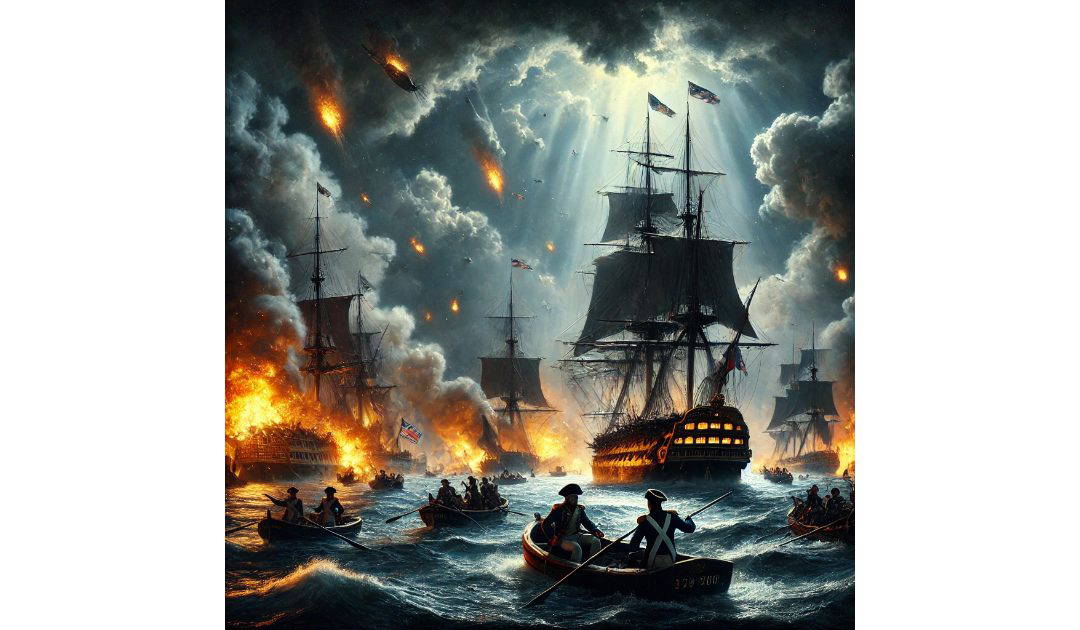The Battle of the Basque Roads, also known in French as the Battle of the Aix Roads, took place between the 11th and the 25th of April, 1809. It was a significant naval conflict during the Napoleonic Wars, pitting the British Royal Navy against the French Navy. The battle occurred near the coast of France in the Bay of Biscay, specifically in the Basque Roads, an area at the mouth of the Charente River, close to the strategic port of Rochefort.
The context for the battle was rooted in the ongoing conflict between Britain and France during the Napoleonic Wars. The British, under the command of Admiral Lord Gambier, sought to neutralise the French fleet, which was menacing British trade routes and posed a threat to British naval supremacy. The French fleet, commanded by Admiral Zacharie Allemand, was anchored at a fortified position in the Basque Roads, making it difficult for the British to attack directly.
In the initial stages of the battle, the British were cautious. They recognised the strong defensive position of the French fleet, which was protected by shoals and sandbanks, as well as by fortifications on the nearby Île-d’Aix. However, the British were determined to capitalise on an opportunity to weaken the French naval forces.
The British formulated an innovative plan to dislodge the French fleet from their protected anchorage. Captain Lord Cochrane, a daring and unconventional officer, proposed the use of fire ships to break the French line of defence. Fire ships were vessels filled with combustible materials, set alight, and directed towards enemy ships to cause chaos and destruction.
On the night of 11th of April, Cochrane led a daring attack using a fleet of fire ships and explosion vessels. The explosive vessels, rigged with gunpowder, were designed to create massive blasts in the midst of the French fleet. This surprise assault aimed to scatter the French ships and leave them vulnerable to the main British attack.
The attack initially succeeded in causing significant confusion and panic among the French. Several French ships were forced to cut their anchor cables in a desperate attempt to evade the fiery onslaught. This disarray allowed Cochrane’s smaller ships to move in and engage the French vessels at close quarters.
Despite the initial success of Cochrane’s tactics, the overall British plan did not unfold as smoothly as hoped. Admiral Gambier, stationed offshore, hesitated to send in his main fleet to capitalise on the chaos, resulting in a missed opportunity to completely destroy the French fleet. This hesitation led to criticism of Gambier’s leadership and command decisions during the battle.
Nevertheless, the British managed to inflict considerable damage on the French fleet. The French ships of the line “Océan” and “Tonnant” were grounded and later destroyed to prevent capture. Several other ships suffered damage, and the overall French naval capabilities in the region were significantly weakened.
The political ramifications of the battle were substantial. Although the British had achieved a tactical victory, the hesitant actions of Admiral Gambier led to controversy and a subsequent court-martial, although he didn’t suffer the fate of Admiral Byng. Cochrane, meanwhile, was hailed for his boldness and ingenuity, though his relationship with the Admiralty became strained as a result of the tensions arising from the battle.
In the broader context of the Napoleonic Wars, the Battle of the Basque Roads was a strategic success for the British, as it diminished French naval power and secured British control over the crucial Atlantic trade routes. The battle demonstrated the effectiveness of unconventional tactics in naval warfare, particularly the use of fire ships and explosive vessels.
The battle also highlighted issues of command and control within the British Navy, with differing opinions on the best course of action. While Cochrane’s audacity proved effective in breaking the French line, Gambier’s cautiousness was viewed as a hindrance to achieving a decisive victory.
In summary, the Battle of the Basque Roads was marked by innovative tactics, leadership disputes, and significant consequences for the naval balance of power during the Napoleonic Wars. It remains a notable example of naval warfare strategy and the complexities of military command.
Thomas Cochrane is, of course, the inspiration for Jack Aubrey in Patrick O’Brian’s Master and Commander series.

